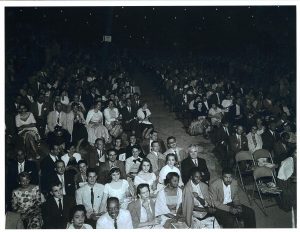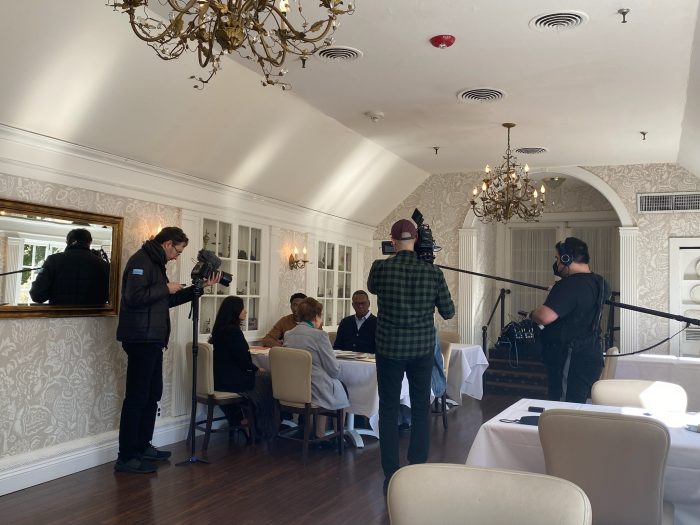For several decades in the 20th century, many who were Black would refer to “The Negro Motorist Green-Book” to find hotels, restaurants and more that would be accommodating when they traveled in a segregated United States.

Recently, Alvin Hall, who has hosted the “Driving the Green Book” podcast about various locations across the U.S., decided to find out if any of the sites on Long Island existed. During his research, he discovered that the Three Village Inn in Stony Brook was featured in the travel guide a couple of times, and he was pleasantly surprised that the hotel was still standing.
Last Friday, Hall and his documentary crew visited the Three Village Inn to film parts of a new documentary series and sat with The Ward Melville Heritage Organization president, Gloria Rocchio, and the inn’s general manager Rae Marie Renna.
The group talked about the travel guide released annually from 1936 to 1966 and published by African-American mailman Victor Hugo Green from Harlem, New York City. The guidebook was the subject of the 2018 movie “Green Book,” winner of the Academy Award for Best Picture, starring Mahershala Ali as classical and jazz pianist Don Shirley and Viggo Mortensen as his driver during one of the pianist’s Southern tours.
The guidebook was published in the spring before people tended to go on vacation during the warmer months, Hall said. It was small enough to fit into an old-fashioned glove compartment, and businesses were able to write in to request to be in it.
Hall said the production team found the Three Village Inn listed in the guide when they were looking at those issued around 1964, the year the Civil Rights Act was passed. The inn was in the 1963 and 1967 editions, according to WMHO. Places such as The Garden City Hotel, Sky Motel in Lindenhurst and Meadowbrook Motor Lodge in Jericho, which were also listed and are still open, will be part of the series, too.
Hall said it’s impressive that places such as Three Village Inn and the other Long Island sites are still standing decades later as many places across the country listed in the Green Book no longer exist.
Hall’s “Driving the Green Book” podcast featured him traveling from Detroit to New Orleans to search for places listed in the travel guide.
“You discover in town after town that often the routing of the interstate highway system was critical to killing off a lot of these places,” he said. “It wasn’t just that the business went down. A lot of it was just that the city decided to build the interstate highway system or major roadway right through that part of town and a lot of it was to kill off the Black business areas.”
When he worked on his podcast, he was on the road for 12 days in 2021 and conducted 40 interviews. It took about a year to edit all the material for the podcast series. With the television documentary, the hope is that it can be completed in a few months.
The producer said the series looks to see what changed in the North after the passing of the Civil Rights Act, what stayed the same, and how the North and South differed.

“It just made sense when you heard some of the stories about Long Island during the time of segregation and Jim Crow in the U.S., and the redlining that banks did out there,” Hall said. “So, it became just an interesting place to explore as sort of emblematic of the larger America.”
Hall said while many thought the North was different from the South, “in reality, a lot of the communities were quite segregated.”
“When Black people came up from the South, they were often put in specific neighborhoods, and a narrative was created around their behavior, their attitudes and everything, and used to exclude them. And, Long Island was no different from the rest of America in that way. I think a lot of people came up from the South thinking it was going to be the land of milk and honey, and it turned out just to be another variation on the South.”
During the visit to the Three Village Inn, Hall along with comedian Ja-Ron Young and college student Chrissy Robinson, who also appear in the documentary, learned about Dogwood Hollow Amphitheater where a festival, featuring various artists organized by Ward Melville, was held. This 2,300 seat amphitheater existed, near where the Stony Brook Village Center’s Educational & Cultural Center is now located, from 1955 to 1970. Rocchio said at first it opened with 500 seats but on the first night 500 more people had to be turned away. Within a year, the occupancy increased. The venue offered shows with jazz performers such as Duke Ellington, Louis Armstrong, Count Basie and Lionel Hampton. Entertainers, including Liberace and Tony Bennett, also graced the stage.
“We found the contracts in the safe,” Rocchio said. “We could never do what [Melville] did. It was hundreds of thousands of dollars each season, having people like Liberace, the King Sisters.”
It’s believed that the Three Village Inn was included in the book because the entertainers stayed there after shows, something that wasn’t the case in many parts of the country as many Black artists would perform in a venue, but then not be able to lodge or eat there.
Hall said it was a progressive move during the era to have a show such as the music festival in Stony Brook where white and Black people performed together and sat unsegregated in the audience.
“I think that by creating the Dogwood festival at the theater, having jazz and having the same people stay there, that was very unusual,” Hall said, adding the movie “Green Book” showed how Shirley’s driver had to use the book to find places for them to stay.
Hall said Young was surprised when he saw one of the photos from the festival where there weren’t segregated sections, something that was uncommon in the 1960s and earlier.
“He said he was amazed at how integrated the audiences were in the photographs,” Hall said. “He says when he plays clubs it’s either generally a white audience with a few Black people, or a Black audience with a few white people. He noted that back then, at that festival near the inn, that it was more integrated than he sees today. You could tell he was quite amazed by that.”
Hall said he included Young and Robinson to show them the journey many took in the 20th century.
“They not only hear the stories, but it’s very important that they hear how the people coped with it, but also how the people did not get trapped in bitterness about the situation,” Hall said. “And they emerged from the opposite side of this with grace, and they acknowledged what happened, and they clearly see it, but they did not get trapped in bitterness.”





